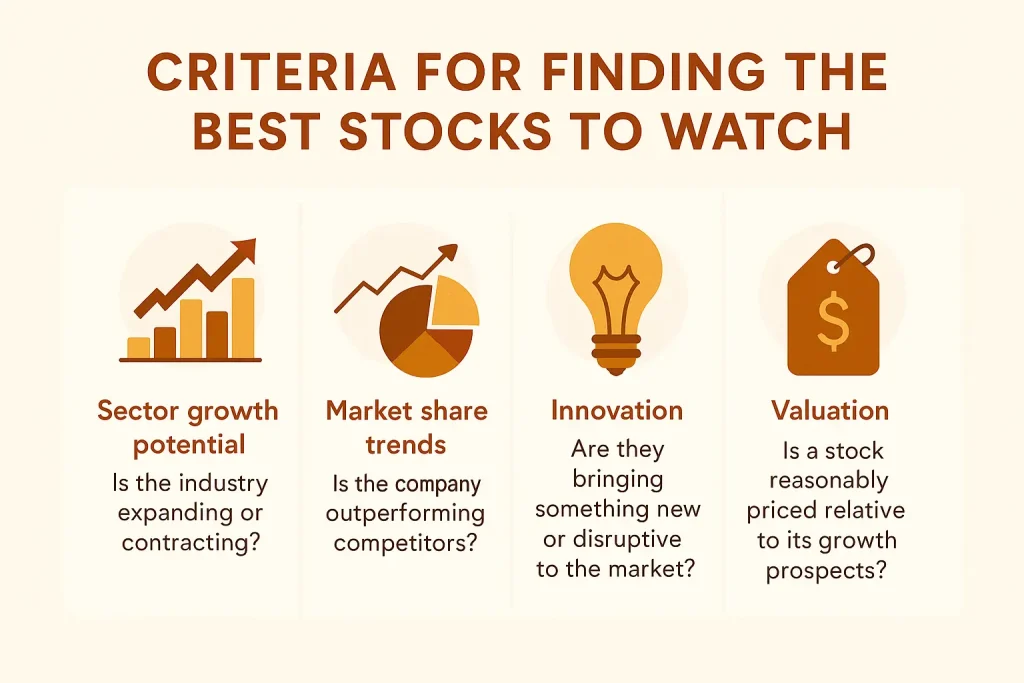In the stock market, the biggest winners often emerge from high-growth sectors. When an industry is expanding rapidly and sustainably, it creates fertile ground for innovative companies to capture market share and deliver strong returns to investors.
In this article, I’ll share my approach to identifying emerging industries, spotting innovative companies, and finding the best stocks to watch—even in sectors that aren’t currently trending.
Why High-Growth Sectors Matter for Investors
When a sector is in a rapid growth phase, companies within it often experience faster revenue growth, stronger earnings, and greater investor interest. This combination can lead to significant stock price appreciation.
Right now, industries such as:
- Cybersecurity – Growing demand for digital protection as cyber threats rise.
- Data centers – The backbone of cloud computing, AI, and digital services.
- Electricity and renewable energy – Driven by global electrification and sustainability goals.
These are expanding at an impressive pace, and companies in these areas could be the next stock market leaders.
Don’t Overlook Stable or Mature Sectors
While it’s easy to focus only on trending industries, new market leaders can also emerge from slower-growth sectors like restaurants or retail.
These sectors may not be considered “hot,” but they can produce remarkable success stories. Especially when a company innovates, captures market share, or reinvents its business model.
Growth on Top of Growth: The Advantage of Sector and Market Share Expansion
A company that is gaining market share in a sector that is also growing benefits from a double growth effect: its own expansion plus the industry’s expansion. This often leads to above-average returns for shareholders.
However, a company doesn’t need to dominate a huge market to deliver big results. Small-cap stocks can multiply in value simply because they start with a low valuation, making percentage gains much larger.
Innovation: The Key Driver Across All Sectors
Innovation is one of the most powerful catalysts for stock price growth, and it’s not limited to startups.
- Startups may disrupt industries with fresh ideas.
- Established companies can reinvent themselves by launching groundbreaking products or moving into adjacent markets.
An innovative approach combined with execution can propel companies forward regardless of sector growth rates.
The Opportunity in Emerging Industries
From time to time, entirely new sectors are born.
Just a few decades ago:
- Social media companies didn’t exist.
- The private space industry was virtually unheard of.
Investors who spotted these emerging industries early had the chance to make extraordinary gains. The key is recognizing their potential before the broader market fully appreciates it.
Often, analysts and fund managers are slow to react, creating a window of opportunity for early movers.
My Criteria for Finding the Best Stocks to Watch
When looking for opportunities, I consider:
- Sector growth potential – Is the industry expanding or contracting?
I prefer industries with durable, multi-year demand instead of one-off hype cycles. I ask what’s driving growth (technology adoption, demographics, regulation) and whether it’s likely to persist through different market environments. If the backdrop is shrinking or stalled, the bar for any stock in that space gets much higher. - Market share trends – Is the company outperforming competitors?
A rising tide lifts everyone; I want names that are gaining share, not just riding the tide. I look for steady wins over multiple quarters—new customer wins, deeper penetration with existing clients, and evidence that rivals are losing ground. Consistent share gains tell me the business model is working in the real world. - Innovation – Are they bringing something new or disruptive to the market?
Innovation should show up in adoption, not just slide decks. I look for products or services that solve real problems, support better pricing, or open new revenue streams. Clear release cadence and customer uptake matter more than buzzwords—they signal that the company is building something sticky. - Valuation – Is the stock reasonably priced relative to its growth prospects?
I’m willing to pay for quality, but not at any price. I compare today’s expectations to the company’s actual growth trajectory to make sure there’s still room for upside. The goal is to avoid overpaying during excitement and to favor entries where fundamentals can realistically outrun the price I’m paying.
While I pay close attention to high-growth sectors, my ultimate focus is on individual companies with strong fundamentals and clear execution, so I can own businesses that can carry their weight through both upturns and downturns.competitive advantages, and room to expand.

Related Reading
For a deeper dive, see:
- Identifying Future Market Leaders During Corrections: how to blend fundamentals with relative strength to spot the stocks holding up best—and poised to lead the next uptrend)
- How to Deal with Market Volatility: My Perspective and Proven Investment Strategies practical tactics for staying invested with guardrails, from sizing and scaling to using protection selectively when risk is elevated
Final Thoughts
High-growth sectors and emerging industries offer incredible opportunities for investors, but so can stable, overlooked markets when the right company comes along.
Whether it’s a cybersecurity startup, a retail chain reinventing itself, or an innovative energy company, the key is finding businesses that combine growth potential, market share gains, and innovation.
Question for you: What sectors and companies are you watching right now for long-term growth?
Disclaimer: This article is for informational and educational purposes only. It does not constitute financial, investment, or legal advice, and should not be taken as a recommendation to buy, sell, or hold any asset. Always conduct your own research and consult with a qualified professional before making any financial decisions. The author and publisher are not responsible for any actions taken based on the information provided in this content.
